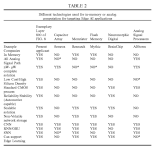Tothemoon24
Top 20
The Audio Revolution at the Edge
In today’s interconnected world, clear and noise-free audio has become more crucial than ever. From wireless earbuds to smart home devices and enterprise communication systems, the demand for high-quality audio processing continues to grow. At BrainChip, we’re excited to introduce our groundbreaking Audio Denoising solution, powered by our innovative Temporal Event Neural Network (TENNs); a platform of use case specific algorithms coupled with our Akida™ event-based semiconductor IP that improve performance and power efficiency. TENNs represents a significant leap forward in audio processing, offering unparalleled efficiency and performance for edge computing applications.
The Challenge of Audio Denoising
Audio denoising, the process of removing unwanted noise from audio signals, has long been a complex challenge in signal processing. Traditional methods often struggle to balance noise reduction while preserving the original signal’s quality. As well, today’s audio pre-processing approaches are computationally and energy inefficient.
Enter TENNs: A New Paradigm in Audio Processing
BrainChip’s Audio Denoising solution leverages the power of TENNs, a revolutionary approach to neural network architecture that excels in processing sequential and continuous data streams. By combining the principles of state space models and generalized convolution kernels, TENNs offers a highly efficient alternative to traditional transformer models, making it ideal for edge computing audio applications.
Key Features and Benefits
Scalable TENNs Models: Our medium-sized model achieves an impressive Perceptual Evaluation of
Speech Quality (PESQ) score of 3.36 with just 590,000 parameters. This demonstrates TENN’s ability to
deliver excellent noise reduction while maintaining audio quality. The TENN architecture allows for easy
scaling to smaller or larger models, adapting to specific customer needs without compromising
performance.
Unmatched Efficiency: TENN models require fewer parameters and multiply-accumulate operations
(MACs) per sample compared to equivalent CNN-based models. In fact, our Audio Denoising solution
uses 12 times fewer MACs and nearly 3 times fewer parameters than state-of-the-art networks, while
providing comparable performance. This translates to significantly lower power consumption and
reduced area requirements when designing System-on-Chip (SoC) solutions.
Hardware IP Integration: Our product includes Hardware IP, enabling companies to seamlessly
incorporate BrainChip AI acceleration into their SoC designs. This integration ensures optimal
performance and efficiency for audio denoising tasks, making it ideal for a wide range of edge devices.
Versatile Applications: From in-ear wireless devices to fixed audio equipment and VoIP systems, our
audio denoising solution caters to a broad spectrum of applications. It can be implemented as a
standalone feature or integrated into a pipeline feeding speech recognition or keyword spotting
systems, which BrainChip is also developing.
Customizable Solutions: With our TENNs license, customers can fine-tune models to their specific
requirements, ensuring the best possible performance for their unique audio environments and use
cases.
Real-World Applications and Performance
Our Audio Denoising solution powered by TENNs has demonstrated impressive results across various
applications:
Enhanced Speech Clarity: Improve the quality of voice calls and audio recordings by removing
background noise and focusing on the speaker’s voice. This is particularly valuable for mobile
devices and hearing aids.
Improved VoIP Communication: Elevate the experience of video conferencing and online
meetings with clearer, noise-free audio, essential in today’s remote work environment.
Smart Home Devices: Enhance the accuracy of voice-controlled smart home systems by
providing cleaner audio input, improving user experience and device functionality.
Industrial Monitoring: Improve the quality of audio data in industrial settings, enabling more
accurate analysis and predictive maintenance.
Medical Devices: Vital sign estimation, allowing for more accurate and power efficient
monitoring of human health.
When compared to state-of-the-art networks for speech enhancement through denoising, our TENNs-
based solution achieved:
– Comparable PESQ scores (3.36 for the medium model)
– Approximately 12 times fewer MACs (Multiply-Accumulate operations)
– Nearly 3 times fewer parameters
These results highlight the exceptional efficiency of our TENNs Audio Denoising solution, making it ideal
for edge computing applications where power consumption and computational resources are limited.
Also note that the ability to execute on raw data eliminates the need for expensive pre-processing.
Implementation and Future Directions
The implementation of our Audio Denoising offering within BrainChip’s hardware, specifically in the
Akida 2.0 IP showcases a significant advancement in hardware-accelerated AI for audio processing.
Akida 2.0’s architecture is designed to fully exploit TENN’s capabilities, featuring a mesh network of
nodes, each equipped with an event-based TENN processing unit.
Looking ahead, we plan to continue refining our Audio Denoising capabilities, focusing on:
Enhancing activation sparsity to further improve efficiency.
Exploring more of the polynomial space to increase model flexibility.
Developing integrated solutions that combine audio denoising with speech recognition and keyword spotting.
A New Era of Crystal-Clear Audio
BrainChip’s TENNs-powered Audio Denoising solution marks a significant milestone in the evolution of audio processing technology. By addressing key challenges related to power consumption and computational efficiency, we’re paving the way for a new generation of edge devices capable of delivering crystal-clear audio in any environment. Our Audio Denoising product is just the beginning of what’s possible with TENNs technology, and we’re excited to see how our partners and customers will leverage this powerful algorithm platform to create the next generation of audio-enabled devices. To learn more about how BrainChip’s Audio Denoising solution can elevate your products, contact us for a demonstration or to discuss your specific audio processing needs.










